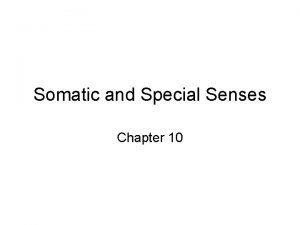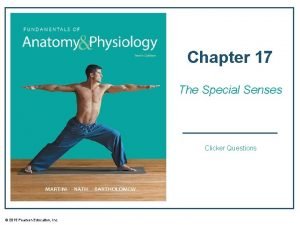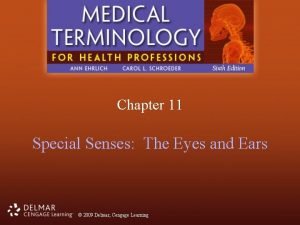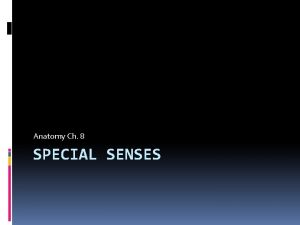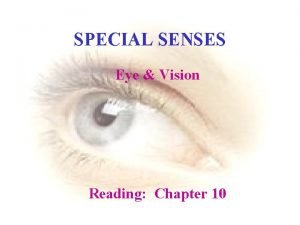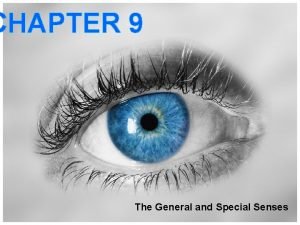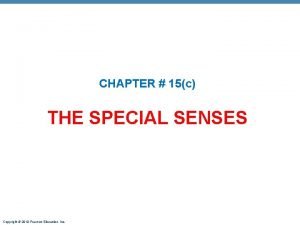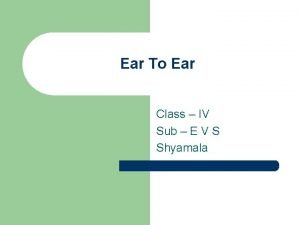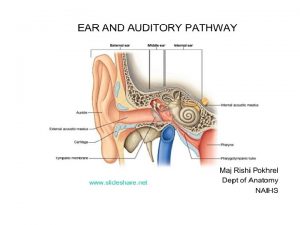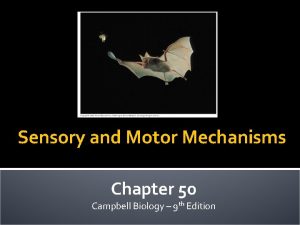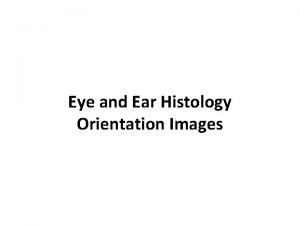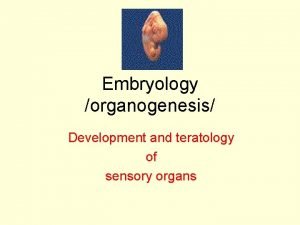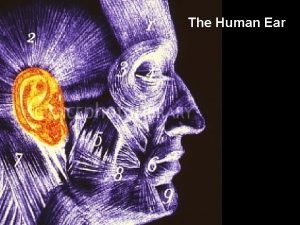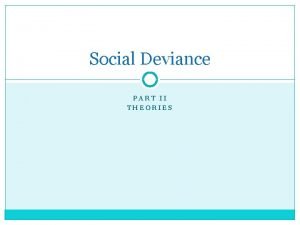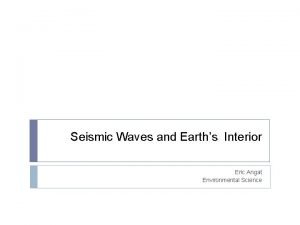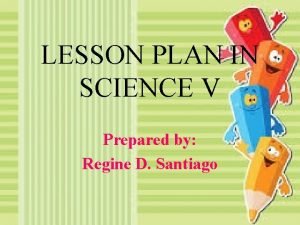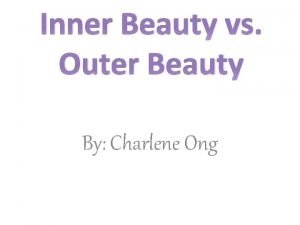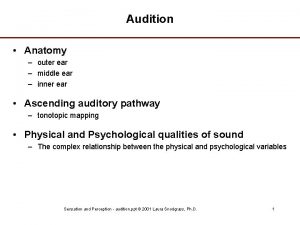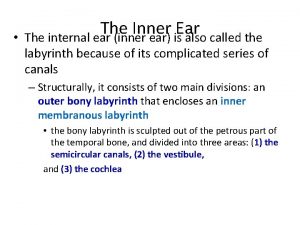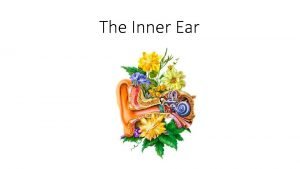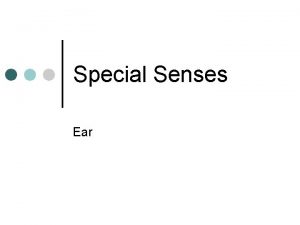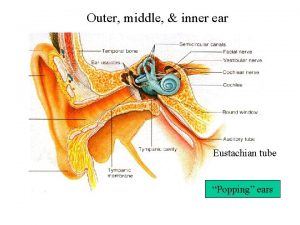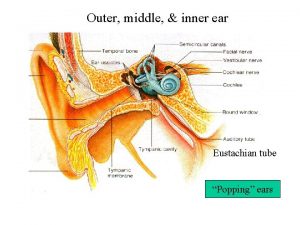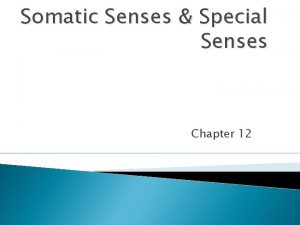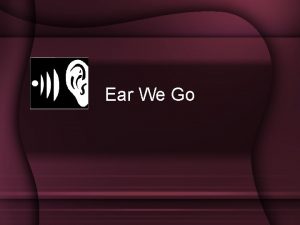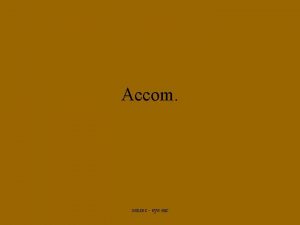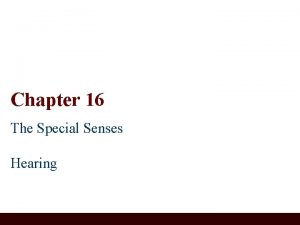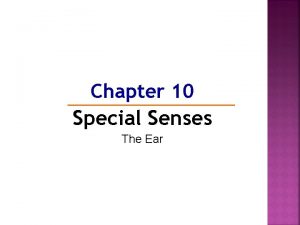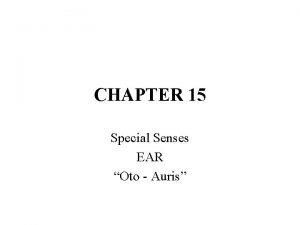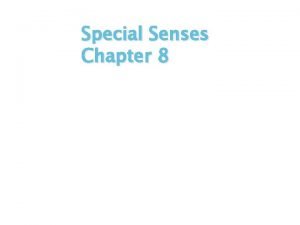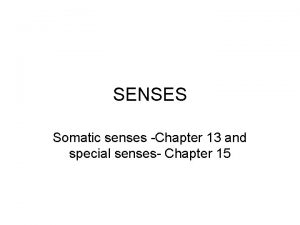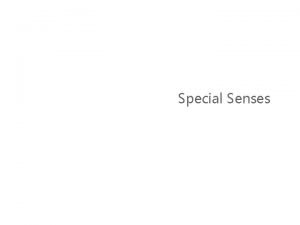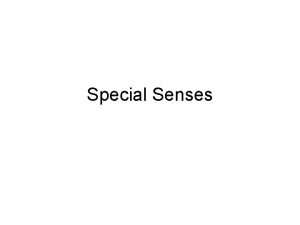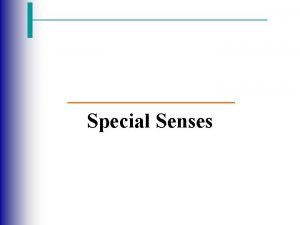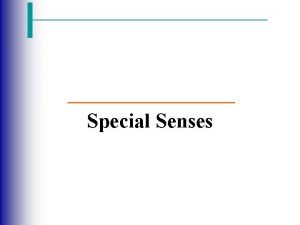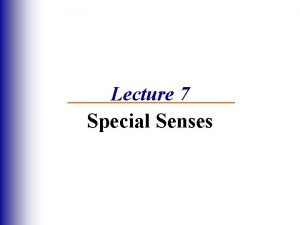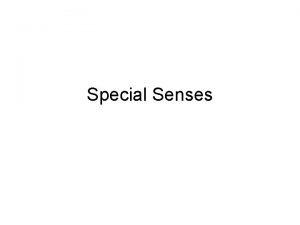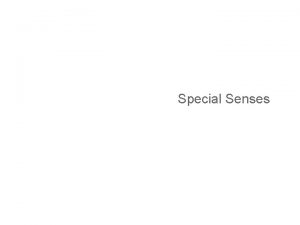Special Senses Chapter 8 Ear outer middle inner


























- Slides: 26

Special Senses Chapter 8

Ear (outer, middle, inner) • Hearing and equilibrium

External Ear • Hearing only! • Auricle (pinna) • External acoustic meatus (auditory canal) • Ends at the tympanic membrane

Ear (outer, middle, inner)

Middle Ear • Air-filled cavity within the temporal bone • Only involved in the sense of hearing

Ear (outer, middle, inner)

Inner Ear (Bony Labyrinth) • Hearing and balance • Filled with perilymph • Bony chambers ▫ Vestibule ▫ Cochlea ▫ Semicircular canals

Inner Ear (Bony Labyrinth) Vestibule has two functions: ▫ Static equilibrium ▫ Dynamic equilibrium

Ear (outer, middle, inner)

• Maculae—receptors in the vestibule ▫ Report on the position of the head ▫ Send information via the vestibular nerve

• Maculae—receptors in the vestibule ▫ Report on the position of the head ▫ Send information via the vestibular nerve

• Crista ampullaris—receptors in the semicircular canals ▫ Tuft of hair cells ▫ Cupula (gelatinous cap) covers the hair cells

Organs of Hearing • Organ of Corti ▫ Located within the cochlea ▫ Receptors = hair cells on the basilar membrane ▫ tectorial membrane is capable of bending hair cells ▫ Cochlear nerve attached to hair cells sends nerve impulses


Mechanisms of Hearing • Vibrations from sound waves move tectorial membrane • Hair cells are bent by the membrane

Mechanisms of Hearing

Mechanisms of Hearing

Olfaction—The Sense of Smell • Olfactory receptors are in the roof of the nasal cavity ▫ Neurons with long cilia ▫ Chemicals must be dissolved in mucus for detection

Olfactory

Sense of Taste • Taste buds house the receptor organs • Location of taste buds ▫ Most are on the tongue ▫ Soft palate ▫ Cheeks


The Tongue and Taste • Tongue covered with projections called papillae ▫ Filiform papillae—sharp with no taste buds ▫ Fungifiorm papillae—rounded with taste buds ▫ Circumvallate papillae—large papillae with taste buds

The Tongue and Taste • Impulses are carried to the gustatory complex by several cranial nerves because taste buds are found in different areas

Taste Sensation • • Sweet receptors(sugars) Sour receptors Bitter receptors Salty receptors

Developmental Aspects • Formed early in embryonic development • Eyes are outgrowths of the brain • All special senses are functional at birth ▫ At birth babies eyes are sensitive to light so pupils remain very small ▫ Over a few months pupils start to dilate and eyes begin to focus on closer objects ▫ Focusing the eyes is learned

Chemical Senses: Taste and Smell • Both senses use chemoreceptors • Both senses complement each other and respond to many of the same stimuli
 Distinguish between general senses and special senses.
Distinguish between general senses and special senses. General senses vs special senses
General senses vs special senses Inner critic inner defender inner guide
Inner critic inner defender inner guide Thermoreceptors
Thermoreceptors Chapter 17 special senses answer key
Chapter 17 special senses answer key Chapter 11 special senses the eyes and ears
Chapter 11 special senses the eyes and ears Anatomy and physiology chapter 8 special senses
Anatomy and physiology chapter 8 special senses Eye anatomy
Eye anatomy Chapter 10 special senses
Chapter 10 special senses The general and special senses chapter 9
The general and special senses chapter 9 Chapter 15 special senses
Chapter 15 special senses Chapter 15 special senses
Chapter 15 special senses Ear to ear class 4 evs ppt
Ear to ear class 4 evs ppt Which animals ears cannot be seen
Which animals ears cannot be seen Antihelical crus
Antihelical crus Ear inner structure
Ear inner structure Cochlear duct
Cochlear duct Ear development
Ear development Supporting cells
Supporting cells Characteristic of mars
Characteristic of mars The brittle, rocky outer layer of earth
The brittle, rocky outer layer of earth Earth mantle definition
Earth mantle definition Differential association example
Differential association example Which type of wave can penetrate the outer and inner core?
Which type of wave can penetrate the outer and inner core? Inner outer planets venn diagram
Inner outer planets venn diagram Inner and outer sphere mechanism
Inner and outer sphere mechanism Explain how physical beauty differs from inner beauty
Explain how physical beauty differs from inner beauty



